December 1, 2006
Press Articles :: Heyoka Magazine - Winter 2006 / Volume 3
Interview with John LeKay
www.heyokamagazine.com
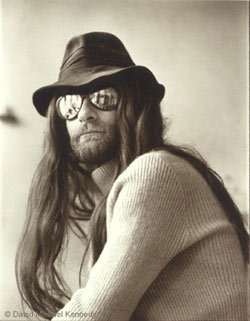 |
| Richard Segalman, Woodstock, NY |
John LeKay: Can you please tell me about the portrait work you did in the 80s - with people like Bob Dylan, Debbie Harry, Muddy Waters, Bruce Springstein, and Richard Segalman (the painter)?
David Michael Kennedy: Yes, Richard is a friend of mine, I have known him for probably about 30 years and I have been photographing him for 30 years. It is kind of an interesting relationship.
JL: I noticed the ones where he looked a lot younger with the long hair - in the picture with the glasses.
DMK: Yeah, actually that's a wig - John (Laughter ). Richard never had long hair. That one is weird on him.
JL: I thought he was like a hippy. (laughter)
DMK: No no no. It was a good time, it was a lot of fun.
I don't even know how to begin talking about the portraits. That was a pretty amazing time in my life. I came back to New York just to have back surgery and had every intention of going back to California and I just kind of fell into doing all of these great pictures of these great people so I stayed in New York for 18 years.
JL: What was the experience like when photographing Bob Dylan?
DMK: Dylan was great. Dylan was really the only person that I was really excited about photographing. Really "in awe"; because I was excited about photographing everybody. But Dylan was the one that made me nervous and really got my heart going. He was an icon to me and it was interesting because when I did it he told the magazine that he did not want a fancy photographer; he didn't want one of these fashion guys that comes with a whole entourage and everything. So when I went to photograph him, I didn't even bring an assistant. I didn't bring anybody. Just me. But I brought a ton of equipment.
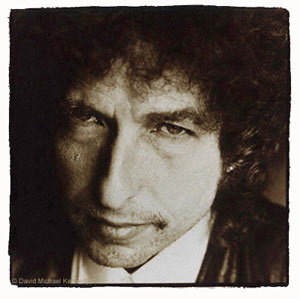 |
| Bob Dylan, Zuma Beach, California 1985 |
JL: So who helped you out - did you have anyone there to help you?
DMK: He did, himself. I had him hanging seamless for me and moving boxes and stuff. And it was great. It was great for two reasons; one, because I was tremendously nervous photographing him; I mean he was an icon - I could hardly talk the night before, I was so excited and nervous. So it really helped to break the ice number one. Number two, it made him feel really comfortable - like he was just one of the guys. It had nothing to do with fancy, with fashion, with photography. It kind of brought us down to an equal working level; so it was just fabulous, it was the best thing I could have done.
JL: Did Bobby have a sense of humor - working with you?
DMK: Yes most definitely. People always used to ask me how I photographed celebrities and how I got them comfortable. I didn't have any secrets; the big secret was I just treated everybody like people. We treated them well. We always had food in the studio, we always cared about them. But, if I was doing a shoot of some street bum - they got treated the same way.
JL: Usually, they would come to your studio, or did you go to their houses or on location?
DMK: Fifty / fifty - a lot of times we would go to their house or we would go on location, but I think that it is really important; the secret, if there was any, was that they just got treated like people.
JL: Regardless of whoever they were.
DMK: Yeah, and we always treated everybody good, so it was not like we didn't treat everybody good. But we didn't treat them special, that you were a star or a celebrity - you were just someone that we were going to work with that day.
PART II - Lakota Dancers
Interview with John LeKay
www.heyokamagazine.com
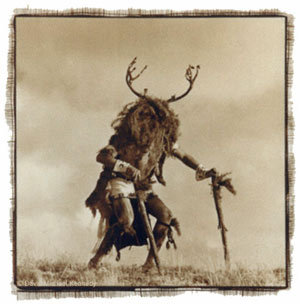 |
|
Picuris Deer Dancer, January 1994 |
JL: How did you get the opportunity to take the photographs of the Lakota dancers out at Pine Ridge?
DMK: Oh God.
JL: Is this an awful question?
DMK: Yes it's an awful question.
JL: Sorry.
DMK: That's ok, part of it, I'm still coming to terms with . But it's good to talk about it. That's part of coming to terms with it. I've always been really interested in native spirituality and I've always felt a kind of kinship to it and I guess the thing that really got me going is when I worked with a guy named Leonard Peltier.
I actually worked a tremendous amount for Bob Guccione at Penthouse magazine. It's funny because a lot of people say they don't buy Penthouse magazine for the pictures, they buy it for the articles. Guccione had tremendous articles in that magazine. His was the first national magazine that did a story on Leonard Peltier, and that's what I did for him. I never photographed the girls. I always photographed the people that they did the stories with. I photographed Elliot Gould for him. I photographed Jimmy Swaggert's hooker for him. I photographed Reverend Fletcher of the PTO for him. I did great stuff for Guccione; wonderful people, very interesting - and important stories (most of them) and important stories that weren't being covered by a lot of other media.
DMK: So anyway, Guccione sent me to Leavenworth prison to photograph Peltier. So, I photographed Leonard in Leavenworth and really felt like a kinship with this guy.
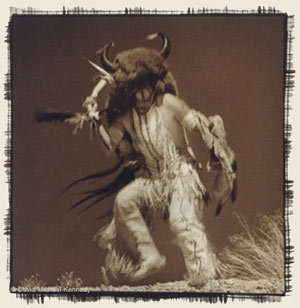 |
|
Nambe Spear Dancer, July 1993 |
JL: So you got to talk to him and hang out with him?
DMK: We spent three or four hours together in the penitentiary and I set up a little studio there and we just hung out and made some pictures and talked.
Amazing man, I really liked Leonard, I really enjoyed him. When I looked in his eyes, man, I looked in his eyes and I don't believe he is a murderer. I don't believe he did any of that shit.
JL: I don't either.
DMK: I mean you read the books and you read the trial transcripts and there is no way you come away and think he did it. So anyway, I left New York and when I got to New Mexico, I really wanted to work with Native Americans and I kind of looked around for a while, and I hooked up with a tseuki buffalo dancer and I talked about the idea of doing a project on ceremonial dance with him.
The first one I did was the 8 Northern Pueblos in New Mexico. That took almost 7 years to do 8 pictures.
DMK: Yeah, because I really needed to do it in a good way and I wanted to do it with permission.
JL: Yes I understand.
DMK: It was a huge pain in the ass because I was dealing with the tribal government and everybody was suspect of what I was doing. And you know the Indians have been ripped off so bad that nobody really trusted me. I still give a percentage of the sales of those prints back to the tribes.
JL: That's cool.
 |
| San Juan Eagle Dancer, August 1993 |
DMK: And, for seven years I fought to get those 8 pictures done and finally we got them done and I felt a little burned out; but my affinity has always been towards the plains Indian. So, when I finished the Northern Pueblo portfolio, I decided I wanted to work with the plains Indians. I went out to South Dakota and I met a bunch of folks on the Pine Ridge Reservation, particularly a woman named Chic Big Crow.
Chic had lost her daughter in a car accident and I had lost my daughter in a car accident and so we had kind of an affinity. There was this nice connection and Chic had started the Sioux Big Crow Boys and Girls Club on the reservation. I had learned my lesson from working with the 8 Northern Pueblo Council that I realized that going through the tribal government was the wrong way to go.
JL: Seven years?
DMK: Because the tribal governments are ripping off the people. It's a huge pain in the ass. So when I went up to Pine Ridge, I was looking for more grass roots people, medicine people, spiritual leaders, people that were involved in the community, people that were more traditional, and were not involved in tribal government per se. So Chic was perfect - she was very involved in the community. She was trying to put together this boys and girls club on a shoestring and I talked to her and told her what I would like to do - that I would like to do this work with the dancers up in South Dakota. And, that I would give a percentage of all the sales to the Sioux Boys and Girls Club. So, the money wasn't going back into the tribal coffers - it was going to a very specific thing.
JL: That's great.
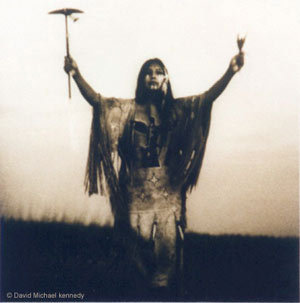 |
| Ghost Dancer Lakota Nation, September 1998 |
DMK: Yeah. In return for that, what I wanted her to do was to introduce me to people; let people know that I'm an ok kind of person, and just kind of help smooth the way with introductions to the people who spiritually ok what I was doing. So she agreed and that took about 7 years to do that too. The way they were done, all of the dancers were ceremonial dancers and a lot of the dances are most of the time dances that are not even seen, much less photographed. But, when I photographed them, none of them were in ceremony. It's like I would go to the ceremonies. I would try and learn about them. I would participate in some of them and eventually I would find a dancer and get permission from the medicine people to do it.
DMK: And then I would take the dancer and go away somewhere, You know, just me and the dancer, out in the hills, out in the plains somewhere and we would photograph it and I felt better about that because I really wasn't interfering with the ceremonies. And so, I really wasn't photographing the ceremonies.
We did it as accurately and traditionally as we could, but at the same time we were outside of the ceremonial situation and that seemed to make everybody feel more comfortable.
JL: Were there any other problems?
DMK: Yes, there's a few inherent problems with it, one of the problems is working with Native Americans. There are always that fringe of people who don't understand what you are doing, that feels - once again - here's another guy ripping off Indian culture.
JL: Yes, like exploiting the culture.
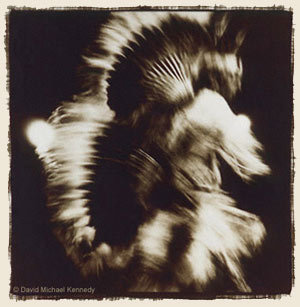 |
| Lakota Fancy Dancer, July 1991 |
DMK: And that was a huge battle, even today that's a huge battle. People see the work and they accuse me of that.
JL: Really?
DMK: I find myself constantly defending what I'm doing.
JL: Like your intentions?
DMK: Yeah, you know you get kind of sick of saying "I'm not ripping anybody off". This was done in a good way, it was done with permission, money goes back to the people.
JL: Yes, it also brings awareness to their cause and what's going on out there.
DMK: Exactly. I thought that this was a really good thing for all those reasons, bringing awareness to the culture, sharing the culture, but I found that there was an awful lot of friction about it and then I started looking at the work and started thinking you know, this work is showing the Native Americans in really good light.
DMK: It's very positive work and you look at the pictures and you hopefully feel the culture; you feel the spirituality and maybe people go away looking at this thinking that the world of the Native American is pretty good right now.
JL: Right.
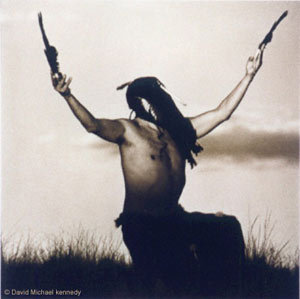 |
| Heyoka Lakota Nation, September 1998 |
DMK: And of course it's not. You know these people are able to find their space to do their ceremonies and to do their dancing, but their life is really hard - poverty, domestic violence, alcoholism. I mean it's really all of the bad stuff - in which our society has permeated their culture. You know, my personal feeling is that it's all a part of the plan to exterminate the race.
JL: Yes I agree with that.
DMK: It has to do with the land, it also has to do with their history because as long as they are around, we maybe - not consciously, but subconsciously acknowledge the fact that we stole all this from them. You know even Congress recently awarded the Lakota people millions of dollar's to the Black Hills. So as long as they are around, they are a daily reminder that we ripped this land off from them. And we sure as hell aren't going to give it back to them. That isn't going to happen. So, what you do is get rid of them so you don't have the memories anymore.
DMK: Because of all of this, I kind of felt like I needed to show the other side of life. I needed to show the poverty; I needed to show the struggle that they have very day.
And so I started work on another series of Indian work which was much more environmental portraiture of them in their homes and on their land.
PART III - On The Road
Interview with John LeKay
www.heyokamagazine.com
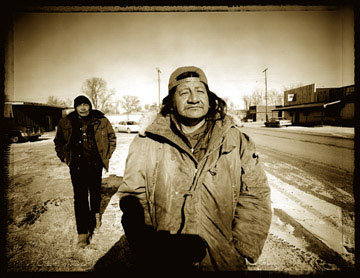 |
| Downtown White Clay Nebraska , February 2003 |
JL: Can you tell me about the town of White Clay?
DMK: The town of White Clay is just across the border from Pine Ridge (they have a population of about 20 in that town) and they sell more alcohol in that town than in any other town in the state of Nebraska because that is where all of the Indians go to drink.
Here is kind of the beginning of the landscapes and the people. This is the beginning of the series. All of these landscapes are on Pine Ridge and all of the people here are Lakota people. So this is where I was going with this. I find it interesting because even though I am showing poor people, people that are drinking; I still think that there is a pride that comes through these people. So it kind of became important to me after doing the two series of dancers to start showing this other side of their life. And so, this series began.
At about the same time this series began, the rest of my life fell apart. This is like in the late nineties. This was one of those crisis points that everyone seems to go through once in a while. I got divorced after 25 years of marriage. My son went away to school and then my house burned down. The shit just hit the fan big time. Then I spent a year and a half rebuilding the house. The only good thing from that period is that I met a great girl, Heather Howard. Somebody came along and wanted to buy my house and so I sold the house and bought the airstream and Heather and I started traveling America.
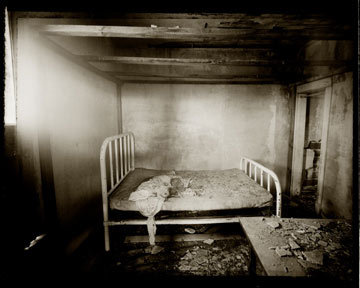 |
| Bed, hwy 27, Gordon, Nebraska November, 2004 |
JL: So where did you head out first? Did you have a plan?
DMK: A had a little bit of a plan. I had a friend in Omaha, Nebraska that owns a really big building here; he's another photographer, the guy's name is Dan Templeton - a very good photographer. He had a big basement in the building that wasn't being used for anything so he told me that I could put my darkroom there. So we set up the darkrooms in Omaha, and then I just took off down the road. When I did it, I thought that it would be just a year. At the end of the year, I would have some great pictures and I would have a good idea of where I wanted to live and then I would just settle down. And now in February, it will be two years and I have no intention of settling down, I really like being out on the road.
JL: So it's kind of gotten into your blood - the nomadic type of lifestyle.
DMK: Yes, but also the photographic type of lifestyle. Initially I thought that what I was going to really enjoy the most and what was going to have the most meaning for me was going to be the landscape work. I was really thinking of it in terms of touring America and photographing landscapes. The portrait aspect of it I didn't really get at that point, but now what I am finding is that the portrait work that I'm doing is becoming more important to me than the landscape work and you know it's amazing to me because I tour down the road; sometimes I'll stop somewhere for a week or several days and other times I'll be driving every day and I'll see interesting people and I'll just stop and start talking to them and only after a couple of minutes I'll just say I would like to do your portrait, can I do your portrait - and it's amazing how everybody says yes. They don't ask why. Sometimes I explain what I am doing. But, most of the time they don't ask why and I'm shooting with a very weird 4x5 camera on a tripod and my portrait exposures range from 1/2 a second to a one second exposure; so they have to hold still - which really involves them in the process. And I am just loving what I am getting. It's just amazing how open and honest people are.
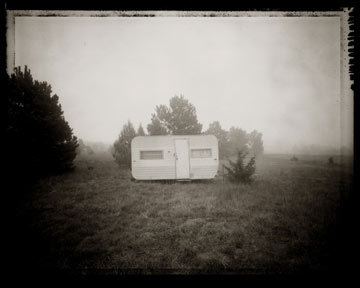 |
| Trailer, Merritt Reservoir, Nebraska October, 2004 |
JL: What are the new works like?
DMK: Wait till you see the new stuff. I am just now finishing up all the stuff I've done up to this point - there's some new cowboy stuff. It just gets better every time. And hopefully in about a week to two weeks, I'll have everything scanned and on the web.
JL: What other places have you traveled to besides out west?
DMK: We have been to the eastern, northernmost tip of Maine to California. We spent a lot of time in Louisiana, in Maine, a lot of time in Texas. The only area that I hadn't really done is the pacific northwest. I had just left Yellowstone Park up in Wyoming and I was heading up into Montana when I freaked out - I couldn't find an internet connection, I couldn't find fed ex, I couldn't get my mail. We were up in a primitive place. We have been pretty much all over the country. There are subsections in there that I like. The long horns in Texas.
JL: The long horn photos in Liberty Texas are really nice.
JL: You've got some great portraits here.
DMK: We met VR Hilton there. We pulled into a gas station. The airstream was parked next to an old truck that had a cattle hauler in the back of it with a long horn in it was really great. So I asked the guy if I could photograph it. The end result was that they invited us to their ranch. We spent three weeks in Liberty Texas staying with this guy VR Hilton who was an all faith minister living in his place going out everyday photographing his long horns.
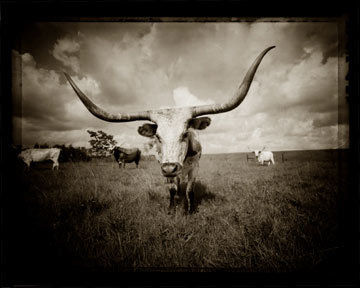 |
|
Longhorn, Liberty, Texas |
JL: You got some amazing shots. Another one that is really interesting is one from key west Florida of that house with the bicycle hanging off of the second floor railings.
From what you have experienced traveling across the US and with what is going on at this time. What are people's sentiments like, or what are they thinking about?
DMK: It is interesting in that people seem to be kind of positive. I am a bit surprised in that with all the bad stuff that's going on in our country right now, I sort of thought that people were going to be more hostile, more uptight - there's a lot of people that seem really kind of worried and freaked out by everything that is going on, but there is a spirit - there's a positive-ness - there's a belief in humanity that seems to run through everybody - there's a picture that is going to go up very soon - a guy named Clarence and his wife Betty. Clarence and Betty they must be in their late 80s. And Clarence just had a heart attack about 4 years ago. Amazing people. Clarence made an electric tractor like 30 years ago. He built it and it runs totally on solar electricity. This is from scraps. Then he built solar panels to heat his house and all his hot water, and the basic component was beer cans. He built this 20 years ago.
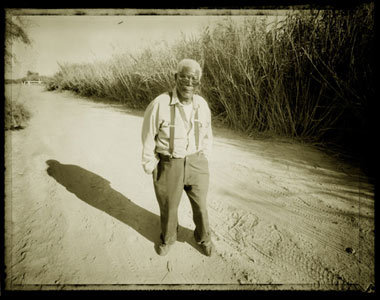 |
| Tommy Chambers, Salton Sea, California |
JL: You photographed this?
DMK: Yes. It is just going out and seeing the ingenuity that they have and the positiveness and the taking control of their own lives, it is very refreshing. It has been very refreshing and a very positive experience meeting all of these folks. And seeing that even with all of the adversity that's going on they still have a belief in themselves and in other people and in life.
JL: Is there any particular place that really stood out in your mind more than any other places, or one particular experience that you've had that you would like to talk about?
DMK: So many of them. I loved Wyoming. I spent time with a wonderful photographer - a guy named Elijah Cobb. I used his dark room. Elijah was a photographer for 18 years in New York City and then he moved to Wyoming. It was wonderful spending time with him. VR Hilton was an amazing man. Everyone was just amazing. Everywhere I go I am meeting incredible people and incredible land.
JL: Are you thinking of doing an exhibition at some point or doing a book?
DMK: Most definitely. An exhibition and a very big book. I have always wanted to do a book - but I didn't want to do a celebrity book or an Indian book; but now I have a very clear definition of what I want to do.
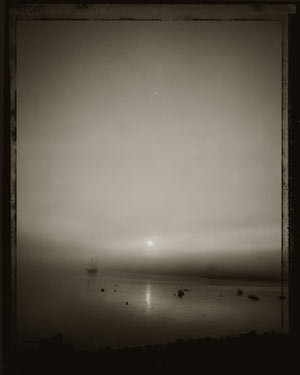 |
|
Boat in Fog, Bass Harbor, Mount Desert Island, Maine |

